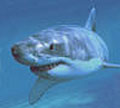
The first satellite tracking of a great white shark off the remote northwest coast has revealed that the deadly predators swim deeper and further from the coast than great whites off the east coast.
CSIRO scientists have watched on their computer screens as Columba, a 500kg, 3.5m female great white travelled 3800km from near Port Lincoln in South Australia to waters off Exmouth in four months.
Hobart-based CSIRO shark expert Barry Bruce, who has pioneered the satellite tracking of large great whites since 2004, said Columba had shown that the species swims closer to the shore, and in shallower water off the east coast of Australia.
“On the east coast, great whites swim about 10km off shore and at about 100m depth,” he said.
“But on the west coast they swim deeper – between 600m and 800m under the surface – and about 100km offshore.”
In 2004, Mr Bruce tracked a male great white, known as Bruce, as it swam from South Australia up the east coast to Port Douglas. It then turned around and returned to South Australia – a journey of 7000km.
Mr Bruce said great whites on the east coast moved north in late autumn and winter while on the west coast they moved north in late spring and summer. Columba was tagged off the Neptune Islands, south of Port Lincoln in South Australia, in late June.
A satellite tag attached to her dorsal fin has beamed back her position and water temperature via satellite, providing real-time information for the first time off the northwest coast.
Right now she is 100km northwest of Exmouth, at a depth of about 600m. She arrived off Exmouth in mid-September after swimming 1200km from waters off Perth in one month.
The satellite tag only transmits when Columba breaks the ocean’s surface, providing a record of the water temperatures experienced by the shark since the last transmission, and Columba’s location. Judging by the water temperature, Columba swam at depths of 600m to 800m.
Mr Bruce said he did not know why Columba had gone to her present location.
A key part of his research was to find the “cues in the environment” that led sharks to travel huge distances. “How do they decide where and when to go?”
“Not too long ago we might have thought that white sharks were territorial and were predominantly coastal,” he said.
“But now we know they move around the continent – and between continents.
“They can go to the tropics and they can dive to a depth of 900m.”
Source: www.theaustralian.nes.co.au











Social Profiles